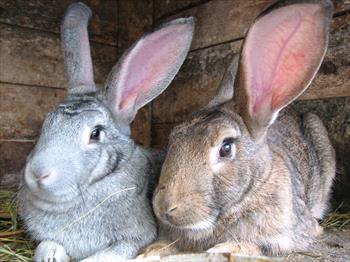Two large rabbits

Photo courtesy of Depositphoto
What is Myxomatosis?
Myxomatosis is a contagious and deadly viral disease of wild European and pet rabbits. Its fatality rate can be devastating, reaching nearly 100% in some cases. Ultimately, though, this percentage depends on the species and breed of rabbit affected and the strain of the virus causing disease. Cases of myxomatosis in the United States are largely limited to the West Coast.
What Causes Myxomatosis?
Myxomatosis is caused by the myxoma virus. This virus occurs naturally in Sylvilagus species (cottontails/related rabbits) in the Americas, but is generally harmless to these rabbits. It was purposely introduced into such places as Europe and Australia to reduce numbers of wild European rabbits. The virus can spread from these wild sources and cause disease in any breed of pet rabbit.
There are many strains of the myxoma virus, some of which are more severe and fatal than others. For example, the Californian myxoma virus in the Pacific states of the U.S. and the Baja Peninsula in Mexico is particularly deadly, estimated to kill over 99% of rabbits it infects. There are similarly severe strains in Europe and Australia, but also weaker strains with death rates around or below 50%.
How is Myxomatosis Transmitted?
- Bites by blood-sucking insects (e.g., mosquitoes, fleas, flies, fur mites)
- Direct contact with an infected rabbit
- Contact with material contaminated by an infected rabbit (e.g., food, bedding, water bottles)
What are the Signs of Myxomatosis?
- Reddened eyelids and eyes
- Discharge (may be milky) from the nose and eyes
- Swollen eyelids, nose, lips, ears, face, anal/genital region
- Skin nodules or lumps
- Drooping ears
- Purple spots on the skin
- Lethargy
- Fever
- Reduced appetite
- Weight loss
- Trouble breathing
- Convulsions
- Coma
- Death
Note: While some rabbits may show obvious and severe signs of illness, other rabbits may show only minor or even no symptoms, but could still die.
How is Myxomatosis Diagnosed?
- Clinical signs
- Lab tests, which include:
- Examining affected tissues under microscope
- Detecting myxoma virus in biopsies or swabs from eyes/nose
How is Myxomatosis Treated?
Because myxomatosis tends to be a severe and fatal disease, veterinarians will often recommend euthanasia of a sick rabbit. In some situations attempts may be made to treat the patient, but unfortunately these efforts are rarely successful.
Treatment may consist of:
- Keeping rabbits warm
- Assisted feeding
- Intravenous fluids (fluids administered through the blood)
- Antibiotics to treat secondary infections
- Pain relievers
- Isolating the sick rabbit from other rabbits
The rabbit’s progression of symptoms, response to treatment and quality of life will all be monitored and play a role in decisions to continue treatment or euthanize.
How can Myxomatosis be Prevented?
- Vaccines are available in some countries (not in the U.S.); 100% protection is not guaranteed
- Quarantine new rabbits
- Prevent contact between pet rabbit and insects/wild rabbits by:
- Keeping pet rabbit inside
- Using insect screens in outdoor rabbit enclosures
- Isolate rabbits suspected or confirmed to have myxomatosis